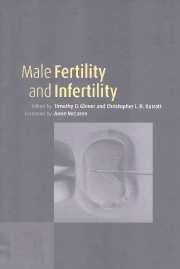Book contents
- Frontmatter
- Contents
- List of contributors
- Foreword by Anne McLaren, FRS
- Preface
- Acknowledgements
- Part 1 Biological perspectives
- Part 2 Implications of the new technologies
- 8 ICSI: the revolution and the portents
- 9 The genetic basis of male infertility
- 10 The treatment of azoospermia with surgery and ICSI
- 11 The challenge of asthenozoospermia
- 12 Molecular techniques for the diagnosis of inherited disorders and male reproductive malfunction
- 13 Gazing into the crystal ball: future diagnosis and management in andrology
- Index
13 - Gazing into the crystal ball: future diagnosis and management in andrology
from Part 2 - Implications of the new technologies
Published online by Cambridge University Press: 09 August 2009
- Frontmatter
- Contents
- List of contributors
- Foreword by Anne McLaren, FRS
- Preface
- Acknowledgements
- Part 1 Biological perspectives
- Part 2 Implications of the new technologies
- 8 ICSI: the revolution and the portents
- 9 The genetic basis of male infertility
- 10 The treatment of azoospermia with surgery and ICSI
- 11 The challenge of asthenozoospermia
- 12 Molecular techniques for the diagnosis of inherited disorders and male reproductive malfunction
- 13 Gazing into the crystal ball: future diagnosis and management in andrology
- Index
Summary
Introduction
We have been given the extremely difficult task of looking into the future of andrology. One only has to consider how intracyto lasmic sperm injection (ICSI) has revolutionized our treatment of the infertile male over the past five years to realize the daunting task facing any-would-be soothsayers. The first experiments in micro-assisted fertilization were in rodent models in the 1970s (Uehara & Yanagimachi, 1976), but out of these exploded the present spectrum of techniques starting in 1992 with Palermo et al.'s report of successful pregnancies following ICSI. What was regarded as incurable male infertility a decade ago is now routinely treatable by the average clinic. Only a handful of visionaries ten years ago could have foretold such a rapid application of basic research to the human arena (Yanagimachi, 1995).
In this chapter we review briefly the history of andrology and attempt to identify key areas that we think will advance our understanding. We are also a bit provocative and argue that the medicalization of human infertility may be a late twentieth century aberration. Is infertility simply an inevitable by-product of our recent evolution, albeit perhaps made worse by our deteriorating human environment? Such a biological perspective may help us to resolve some of the ethical, religious and legal tensions that surround reproductive technology. It may even help infertile couples to an understanding and acceptance of their condition, because we also need to recognize that there may be ethical, economic and medical limits to the development of andrological techniques.
- Type
- Chapter
- Information
- Male Fertility and Infertility , pp. 248 - 266Publisher: Cambridge University PressPrint publication year: 1999



